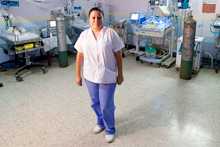
Key Challenges in Scaling Up the Global Health Workforce—and Some Solutions
How can countries increase the number of qualified health workers and improve their performance? How can they attract health workers to serve in rural areas? On November 3, CapacityPlus's James McCaffery and others discussed key challenges in scaling up the global health workforce. Interactive roundtable
Interactive roundtable
“Pharmacists, Doctors, Nurses, Oh My! Solving the HR Problem in Developing Countries” took place in Washington, DC, hosted by the Global Health Council and the Results for Development Institute. Other panelists were Marty Makinen of the Results for Development Institute and Marko Vujicic of the World Bank. Estelle Quain of the Office of HIV/AIDS, USAID Bureau of Global Health served as a discussant.
McCaffery began by sharing an overview and eight key recommendations from the Global Health Workforce Alliance’s forthcoming report, “Will we achieve universal access to HIV/AIDS services with the health workforce we have? A snapshot from five countries.” The report—which CapacityPlus contributed to by serving as the secretariat for the technical working group—will be launched at the Second Global Forum on HRH.
Key policy areas
The panel drew on the report’s recommendations by focusing on three key policy areas that are critical for health workforce scale-up: costing and financing, HR management (HRM) systems, and interventions for rural retention of health workers.
McCaffery led a discussion on HRM, and summarized one key point by noting that it will be difficult to see any sustained progress in scaling up the workforce without stronger HRM systems.
Makinen presented a case to stimulate discussion on the importance of more accurate costing of policy interventions, and the need to involve a greater range of stakeholders in the decision-making process.
Vujicic used the new WHO retention policy guidelines to stress that no one intervention will solve the problem, and that it will require a specific bundle of interventions that best fits a particular country’s context. (CapacityPlus is also working with WHO and the World Bank to develop a retention survey methodology and costing approach).
Quain noted that there were many helpful tools coming on line to help in health workforce strengthening including the ones discussed during the session.
The session was the fourth installment in the series New Visions for Improving Health Care in the Developing World.
Photo by Trevor Snapp. (Health worker in Guatemala)


